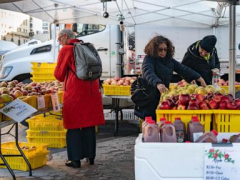The pollution from food is sneaky. Because the apple sitting on your kitchen counter isn’t really causing any harm.
But chances are good that you didn’t pick it from a tree in your backyard. It required land and water to grow, machines to harvest and process, packaging to ship, trucks to transport and often refrigerators to store. Much of that process releases planet-warming greenhouse gases into the atmosphere.
That’s why the global food system makes up roughly a third of worldwide, human-caused greenhouse gas emissions, according to the EDGAR FOOD pollution database.
Meanwhile, roughly a third of the U.S. food supply is lost or wasted without being eaten, according to the U.S. Department of Agriculture. It might never get harvested, it might spoil in transit or the grocery store might reject it for being the wrong size or color. That’s a big reason why some consumers are looking for less-wasteful alternatives ranging from farmers markets to delivery services for produce that didn’t meet supermarket size or appearance standards.
“There’s a whole breadth of opportunities to purchase food,” said Julia Van Soelen Kim, food systems adviser with the University of California Cooperative Extension.
And during the week of Thanksgiving, this decision is especially high stakes because lots of grocery shoppers are buying for extra guests, and more food can mean a bigger climate impact.
Here are tips for reducing impact by shopping beyond the grocery store.
Jane Kolodinsky, professor emerita at the University of Vermont and director of research at Arrowleaf Consulting, has bought her produce directly from a local farmer for 30 years.
It’s called Community Supported Agriculture, or CSA. At the beginning of every harvest season, Kolodinsky pays that farm a fee. Then, once per week, she picks up a box of produce at the farm. Some CSA programs pick the produce, while others let you customize. Some deliver. An online database shows which farms participate in CSA programs.
Since the food is grown nearby, there is less processing and packaging. “There’s a smaller carbon footprint for purchasing locally compared to global or national food distribution channels,” said Van Soelen Kim. “When they’re local, they’re traveling less distance, so less gas, less fuel.”
Local farmers are also likely to grow whatever works best for the area’s climate and season. “When things are in season, they need less storage time, so less electricity for cold storage,” said Van Soelen Kim, who added that can also mean a smaller food bill.
It’s not pollution-free, because the crops still require land and water, and the food does travel some distance. But CSAs avo





